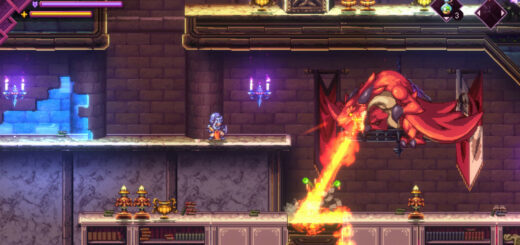Desert Child E3 Impression
Desert Child is a unique take on RPG conventions that bucks the norm in both its narrative and gameplay. This is not a game about saving the world with swords and shields. Instead, the game starts on a ruined future Earth where the player needs to scrounge $500 to get to Mars. It’s never quite explained how Mars has become more hospitable than Earth and how $500 is enough to get you there, but that’s beside the point. Once on Mars, the player gains the new goal of entering and winning the Grand Prix hoverbike race. Doing so is not so simple, as not just anyone can enter the Grand Prix of hoverbikes. Entering the contest requires notoriety, and winning takes sacks of cash for bike upgrades.
Exploration plays out similarly to an adventure game. The player moves through fixed paths on 2D pixel-art environments. Locations allow players to enter races, take odd jobs for money, buy food, upgrade and fix their bikes, and a number of other options. Instead of traditional RPG combat, the action takes the form of a shoot-’em-up racing game. Players race against opponents and can shoot their fellow competitors to slow them down. They must also avoid obstacles and maneuver to collect money scattered around the stage. Players can also slam on the boosters for a temporary speed increase, which can also be used to ram the course’s standard-issue ammo truck to refill ammunition.
The shoot-’em-up racing mechanic returns in most of the odd jobs that bankroll the bike upgrades. For example, delivering pizzas involves riding on a stage and shooting pizzas at customers. The pizzas have different trajectories than bullets, and rather than focusing on speed, pizza delivery is focused on shooting accuracy, keeping things fresh. The bike upgrade system is also unique, requiring players to fit irregularly shaped bike parts — which can bought or stolen from other bikes — on a grid, and connecting them to a power source with power blocks. It’s essentially a puzzle about laying pieces out on a limited space to fit and connect as many as possible. Overall, it feels very similar to designing circuit boards.
Desert Child features a unique aesthetic that is based on hip-hop influences, the camera perspectives of modern 2D adventure games, and retro game-style pixel art. The pixel art is quite detailed and vibrant, and features fluid animations. The game will also include a local multiplayer mode so friends can race against each other; the single player mode will offer roughly 65% racing and 35% exploration. The game is teeming with original ideas and concepts in all of its core aspects, and the demo was very fun to play. It’s definitely one to keep an eye out for when it launches for PC, Mac, PlayStation 4, Xbox One, and Nintendo Switch later in 2018.
















Recent Comments